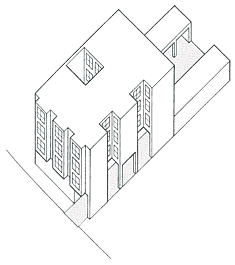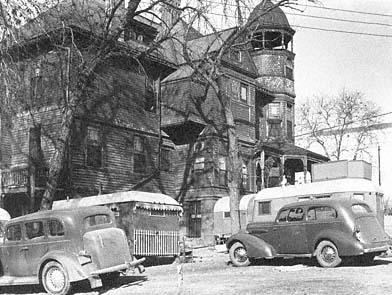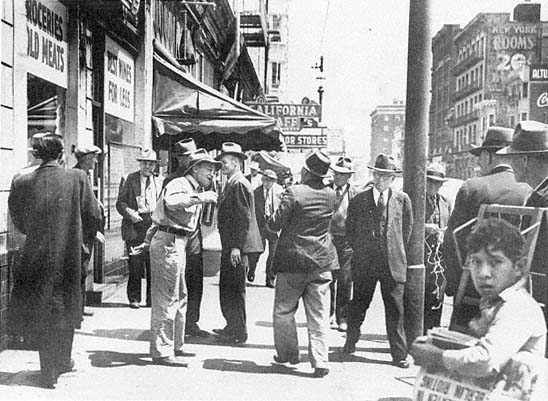Other Changes for Hotel Tenants
As suburban employment surged for people with cars, the situation for non–car-owning residents of cheap rooming and lodging houses became grimmer. White-collar work continued to boom downtown, but blue-collar work did not. As part of the shift of use from streetcar and railroad to automobile and truck, workshop employers and shipping firms moved to outlying highway locations. San Francisco's port lost cargo traffic to more modern ports; buildings in San Francisco's South of Market became underused. Elsewhere in the downtown, employers were eliminating jobs through mechanization. Supervisors called for steadier family-tied workers instead of politically volatile, floating groups hired for short periods. Adoption of shorter workdays meant that more employees had time for commuting to more distant homes. These factors drastically changed the needs for downtown housing and the social roles of workers' districts. Younger laborers and family men did not pass through the skid

Figure 9.4
Small residential hotel with automobile
parking in the back. The Hotel Eddy,
with about 16 units, was a concrete
frame structure built in the early 1920s
in San Francisco's Western Addition. The
two carports at the back sheltered 10 cars.

Figure 9.5
Informal parking lot adjoining a rooming house in Omaha, Nebraska, 1938.
row as often as they had in the 1940s. Older, hard-to-employ men and the home guard were no longer a substrata but a primary proportion of the population (fig. 9.6). By 1960, welfare departments were referring more unemployed downtown people—especially the elderly—to hotels for temporary housing that tended to become permanent. As Joan Shapiro has written, this was often the beginning of an unplanned and unwilling interdependence between social services and hotel owners.[13] In 1961, officials from Minneapolis, Kansas City, and Norfolk seemed confident that demolition of several blocks of their respective

Figure 9.6
Older postwar population left on Howard Street in San Francisco's South of Market, 1953.
skid rows had permanently scattered their residents.[14] Enough vacancies still existed so that, indeed, most people displaced from the cheapest lodging houses could find some other place to live, probably at a higher proportion of their income or savings.
At middle-income levels, the national redefinition of old age brought other changes in the residential hotel market. Social security began to supplement retirement incomes in 1935. Fewer elderly men and women lived with their children, and people over sixty-five years of age began to create a new consumer market. Commercial care for the elderly and the supply of units in bona fide retirement communities improved markedly between 1940 and 1970, competing with yet another role played by midpriced hotels and rooming houses.[15]
A sudden influx of former mental hospital patients constituted a massive change for SRO tenancy. In the mid-1960s, the well-intentioned (and budget-cutting) decision of many states to mainstream mental hospital populations had been coupled with promises of half-way houses and group homes. Modern psychiatric medicines made this release possible. In California, the population of the state mental hos-
pitals declined from 37,000 to 7,000 between 1960 and 1973. However, the halfway houses were never established. Patients were essentially dumped into downtown hotels where neither hotel staff nor residents were prepared for the care required by these new neighbors. In conversation, tenants and managers alike often mention the arrival of publicly supported but inadequately served mental patients as the last blow to pleasant SRO life downtown. As one hotel owner put it, "Suddenly you weren't managing a building; you were running a nut house."[16]
In spite of all these shifts, not all residential hotels were dying. Through the 1960s, hotel rooms at every price range were a smaller but still surviving and viable housing market. A sizable population of healthy, usually single, and often elderly people still lived downtown in hotels and chose that style of housing. By the late 1960s, the formerly ample supplies of lodging house rooms were filling up. In the cheapest hotels that remained open in 1970, the arrival of new desperate tenants and the departure of the better tenants (for better hotels, apartments, or suburban life) left thousands of hotels packed with what one social worker in the mid-1970s described as "a human residue of the elderly and poor."[17] Ironically, the market-driven declines in hotel life were largely intended and carefully planned as part of the official rebuilding of downtown.